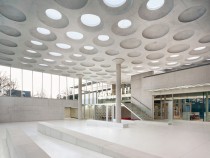
© Brigida González
The entire coffer-studded underside of the reinforced concrete roof atop the new Forum at this secondary school in Adelsheim is visible. The school addition takes the shape of a bright, two-storey hall along the street; at its rear a gallery with café and library links different levels of the addition to the existing structures, which date to the 1960s and 1970s. The main load of the roof is borne by a row of 3 central columns.
Weight and deflection of the long-span exposed-concrete deck are reduced by means of 4 different types of coffers; as a desirable side effect, they also significantly improve the building’s acoustics. The regular pattern, in the form of cycloid depressions, continues through the structurally crucial zone near the columns and the edge of the roof. The coffers were created by mounting domed pieces of styrofoam to the formwork. Corresponding to the geometry, two thirds of the reinforcement between them runs diagonal to the edge of the roof.
The concrete’s marble-white tone is produced by iron cinder; following removal of the formwork, only a lazure was applied. The 3 tapering main columns made of centrifugal concrete are held in place by large pier foundations. Drainage from the roof flows within their inner cavities. The characteristic support heads were originally intended to direct the loads from the ceiling deck. Over the course of the planning process, this role was assumed by puncture-shear reinforcement in the ceiling. The funnel-shaped, precast reinforced concrete units no longer play a role in the structural system, but were retained and, like classical capitals, articulate the transition between two fundamental architectural elements: column and roof.
Weight and deflection of the long-span exposed-concrete deck are reduced by means of 4 different types of coffers; as a desirable side effect, they also significantly improve the building’s acoustics. The regular pattern, in the form of cycloid depressions, continues through the structurally crucial zone near the columns and the edge of the roof. The coffers were created by mounting domed pieces of styrofoam to the formwork. Corresponding to the geometry, two thirds of the reinforcement between them runs diagonal to the edge of the roof.
The concrete’s marble-white tone is produced by iron cinder; following removal of the formwork, only a lazure was applied. The 3 tapering main columns made of centrifugal concrete are held in place by large pier foundations. Drainage from the roof flows within their inner cavities. The characteristic support heads were originally intended to direct the loads from the ceiling deck. Over the course of the planning process, this role was assumed by puncture-shear reinforcement in the ceiling. The funnel-shaped, precast reinforced concrete units no longer play a role in the structural system, but were retained and, like classical capitals, articulate the transition between two fundamental architectural elements: column and roof.




